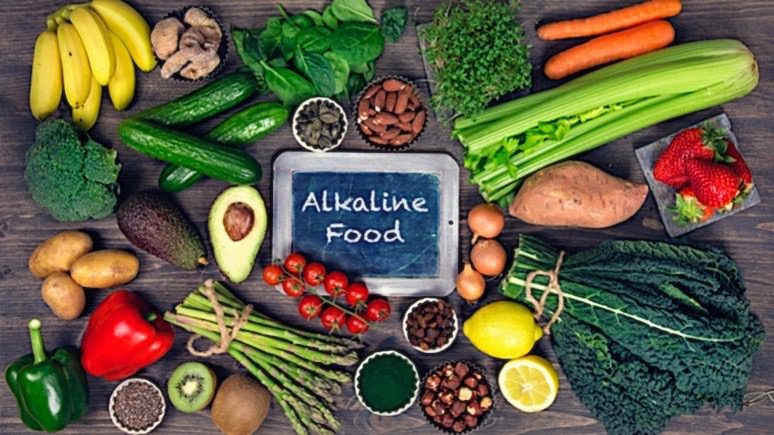Introduction
An Alkaline diet, as well known as the acid-alkaline diet or alkaline ash, encourages reduced eating of acid-forming products along with emphasizing ingesting more alkaline products to maintain your body’s acidity at healthy levels.
The Alkaline nutrition plan encourages including more alkaline products, particularly fresh vegetables and fruits, in the dishes while discouraging acidic products. This eating pattern should keep your body’s pH at the optimal level, boosting overall health. The idea is that foods that leave acidic metabolic waste after intake can elevate the acidity of your body’s pH. As a result, it can increase your susceptibility to illness. Such foods include but are not limited to meat, refined sugar, wheat, and prepackaged food. At the same time, the consumption of foods that leave alkaline metabolic waste increase the alkalinity of your body’s pH. This helps you to stay healthy as well as boosts the protection of your body from illnesses.
Among the benefits of the Alkaline diet are weight loss, prevention of arthritis, certain types of cancer, diabetes, and reducing gut symptoms.
Key points
If you stick to the Alkaline diet, you should give preference to alkaline products and reduce consumption of acidic products to a minimum. You ought to choose nutrient-dense products that have a high pH value. However, do not forget to check for an appropriate range of proteins, fats, and carbohydrates in the foods when planning your dishes.
The idea of this diet is based on the impact of some foods on your body’s pH levels. The pH value is the measurement of acidity and alkalinity. So, eating more alkaline meals may keep your body’s pH value in the normal range as well as enhance your overall health.
All products can be divided into three types: acidic, neutral, and alkaline. Dairy, fish, alcohol, grains, meat, eggs, poultry, packaged snacks, canned foods, and convenience products are considered acidic foods, so their intake should be excluded from your meals. Instead, you should focus on eating tofu, vegetables, nuts, fruits, legumes, seeds, and other products that belong to alkaline foods. Neutral food contains natural lipids, sugars, as well as starches, and you can include it in a moderate amount. Nutrients that leave acidic waste include sulfur, phosphate, and proteins. Conversely, calcium, magnesium, and potassium are known as alkaline food components.
As part of the Alkaline diet, you should also stop drinking caffeine.
This diet plan does not require specific eating times or calorie restrictions.
Contraindications
There are no contraindications for the Alkaline nutrition plan.
How to avoid possible nutritional deficiencies
Since an Alkaline diet limits many food groups, it can result in group B vitamins, iron, magnesium, selenium, omega-3 fatty acid, and zinc deficiencies. Therefore, you should be careful when planning your meals to make them balanced and nutrient-dense.
- B group vitamins: spinach, leafy greens, avocado, lentils, green peas, fresh mushrooms, asparagus, tofu, and sunflower seeds.
- Iron: spinach, legumes, pumpkin seeds, sesame seeds, broccoli, edamame, and tofu.
- Magnesium: avocado, almonds, lentils, soybeans, chickpeas, beans, tofu, seeds, bananas, and leafy greens.
- Selenium: baked beans, sunflower seeds, fresh mushrooms, spinach, lentils, and bananas.
- Omega-3 fatty acid: flaxseeds, chia seeds, soybeans, and edamame.
- Zinc: legumes, hemp seeds, pumpkin seeds, sesame seeds, squash seeds, almonds, fresh mushrooms, and kale.
You should also consider taking vitamin and mineral supplements to support your body with all its needs.
Tips on improving your dieting experience
- Although citruses are sour, they are alkalizing components, so adding fresh lime or lemon to your water is beneficial.
- Consider adding various herbs and spices to your meals to make them more delicious.
- You should monitor your first morning urine for pH level to track how your diet impacts your body’s acidity. The optimal value range is between 6.5 and 7.5.
- You should filter tap water before drinking it. Tap water has an acidic pH and is full of toxins, so it is beneficial to filter it.
- Psyllium husks are great sources of fiber. You should take a teaspoon of husks mixed in a glass of water daily to provide your body with soluble and insoluble fiber.
Conclusion
Though the Alkaline diet is restrictive, it is quite a healthful eating pattern promoting the consumption of healthy plant foods and excluding animal and processed foods.
Unfortunately, human studies have not proven the health-improving effect based on the alkalizing effect of certain foods. Only some studies have shown optimistic effects in a small portion of the population. However, an alkalizing diet low in protein might help people experiencing kidney disease.
Generally, the Alkaline diet is considered healthy because it excludes packaged foods and refined sugars. However, no reliable proof confirms that the effect of this eating pattern is due to changes in the pH value of the body.














Leave a Reply
You must be logged in to post a comment.